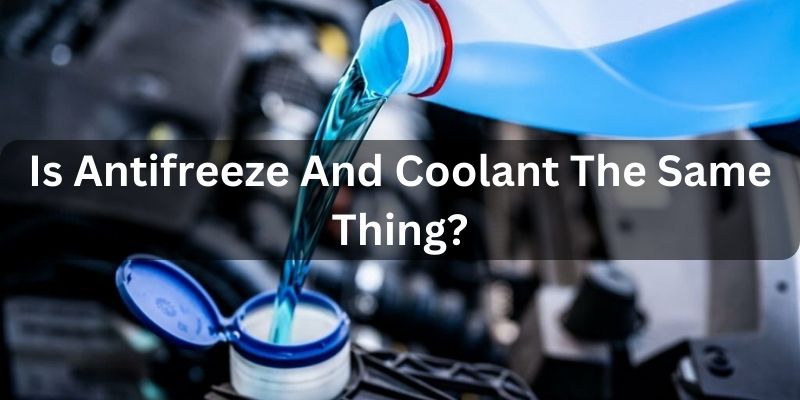Whether you call it antifreeze or coolant, the liquid used in your vehicle’s cooling system serves a crucial dual purpose. On hot summer days and cold winter nights, it circulates throughout the engine’s core, regulating temperatures to prevent overheating or freezing. But it is still confusing for new drivers, is antifreeze and coolant the same thing or different?
This blog article is to solve the confusion of people asking the same thing in comments about whether engine coolant and antifreeze are the same and what they should use.
This blog will solve this confusion about whether antifreeze and coolant are the same things and what are the differences between engine coolant and antifreeze.
Let’s explore what color antifreeze and coolant are and what is antifreeze and coolant used for. Firstly, we will learn the meaning of coolant and antifreeze then the whole confusion between these radiator fluids will be solved.
What is Antifreeze?
Antifreeze is an additive that is mixed with water to form a coolant for use in automotive and other cooling systems.
At its core, antifreeze is composed of ethylene glycol, which remains liquid at sub-freezing temperatures when mixed with water.
Antifreeze is used in car radiators during winter and without making a coolant mixture. In cold climates where the temperature drops below zero, antifreeze is used in radiators instead of water. Antifreeze has a freezing point below 32°F that allows engines to work smoothly in colder climates.
What is Coolant?
Coolant and antifreeze are often used interchangeably and both have the same purpose to protect the engine from freezing and keep your engine cool by dissipating the heat from the engine.
Coolant is a water-based solution with ethylene glycol as the main active ingredient. Ethylene glycol possesses two key properties, it lowers the freezing point of water and raises the boiling point.
By depressuring the water’s freezing temperature, coolant ensures liquid circulation even on bitter winter days. Its higher boiling point allows the coolant to effectively regulate engine temperature without overheating during intensive summer.
Coolant also acts as a corrosion inhibitor, protecting radiators and other metal surfaces from erosion over time.
Coolant is a mixture of antifreeze and water. It comprises 50% of water and 50% of antifreeze. It is commonly used during the summer.
Difference Between Coolant and Antifreeze
Coolant or AntiFreeze have the same purpose and are sometimes named as the same thing but there are some key differences between coolant and antifreeze.
1. Composition
While coolant and antifreeze are often used interchangeably, there is a key difference in their composition.
Coolant is a water-based solution that contains ethylene glycol as well as additional additives. It is formulated by mixing water and antifreeze. The main ingredients are:
- Water – Makes up the majority (50-70%) of the overall solution. Acts as the transfer medium for heat absorption and dissipation.
- Ethylene Glycol – The main active antifreeze ingredient (25-45%). Lowers the freezing point and raises the boiling point of water. Allows circulation in sub-freezing weather.
- Additives – Small amounts of additives like rust inhibitors, lubricants, dyes, etc (5-10%). Help protect metal components from corrosion and wear over the long term.
So in its fully formulated state for use in vehicles, coolant contains water, ethylene glycol, and various supplemental additives developed for maximum effectiveness.
Antifreeze, on the other hand, strictly refers to ethylene glycol alone. It is the ingredient that is mixed with water to depress the freezing temperature so the coolant can flow freely even in very cold conditions. Antifreeze lowers the freezing point well below 32°F as needed for winter driving.
2. Primary Function
Although both coolant and antifreeze help regulate an engine’s temperature, their primary functions differ slightly based on their intended uses.
Coolant’s main purpose is maintaining optimal operating temperature for engines in all seasons and environments. It circulates constantly, absorbing excess heat from hot internal components and transferring it to the radiator for dissipation into the air. This temperature control is crucial for peak performance and preventing overheating issues throughout the year.
Without coolant, an engine could quickly overheat on hot summer days due to a lack of effective heat removal. It’s circulation and thermosiphon action keeps vital parts like the cylinder heads and blocks from sustaining damage. Coolant allows engines to run safely and efficiently regardless of outside weather extremes.
Antifreeze’s core function, as its name suggests, involves protecting the cooling system specifically against freezing. When mixed with water, it lowers the freezing point well below 32°F so that liquid can continue circulating and prevent ice buildup even on very frigid winter days.
While it still aids temperature regulation, antifreeze’s primary goal centers around allowing trouble-free operation when temperatures drop near or below freezing – keeping components deformation-free. It ensures wintertime driving will not lead to freezing damage.
3. Usage
While coolant and antifreeze effectively serve the same purpose to protect your engine, there is a notable difference in how each term is applied and used:
Coolant refers to the full premixed solution that is used year-round in vehicle cooling systems. It is commonly filled in coolant reservoirs during summer. It encompasses the water, ethylene glycol, and additional additives formulated and tested to work together seamlessly.
On the other hand, antifreeze technically denotes only the main glycol ingredient before it is mixed with water. Raw antifreeze is added as needed to achieve the proper glycol concentration. Antifreeze is widely used in colder climatic regions during winter.
Type of Antifreeze and Coolant
Here are the main types of antifreeze and coolant:
Traditional Ethylene Glycol
- Type: Antifreeze concentrate
- The original type uses ethylene glycol that needs to be mixed 50/50 with water to become a full coolant solution
- Provides freeze and corrosion protection, but only last 3 years or 36,000 miles
- Requires occasional coolant flushes
- Commonly used as coolant in older cars
Extended Life Coolants
- Type: Prediluted coolant
- Contains enhanced additives like silicates, phosphates, and amines
- Offers doubled lifespan of 5 years or 100,000 miles before replacement
- Lower toxicity with improved protection against corrosion
Organic Acid Technology (OAT) Coolants
- Type: Prediluted coolant
- Use organic acid instead of silicates for longer-lasting protection
- Specifically recommended for some European or Asian import vehicles
- It can last up to 5 years or 150,000 miles with proper maintenance
- Considered the most advanced coolant technology currently
Within these broad categories, different brands also offer supplemental additives that adjust specifications like freeze point, pH level, and color for optimal performance.
How do I know if I need coolant or antifreeze?
Here are some tips to know whether you need coolant or antifreeze for your vehicle:
- Check your owner’s manual – It will specify whether the manufacturer recommends using pre-mixed coolant or antifreeze concentrate. Follow these guidelines.
- Look at the reservoir – Pre-mixed coolant is usually dark green. If the existing coolant is light or discolored, it may be diluted and need antifreeze added.
- Check freeze point – Coolant should protect down to -34°F. If temperatures will drop lower in your area, you may need stronger antifreeze protection.
- Test coolant strength – Use a refractometer or test strip to check glycol concentration. Below 33-50% means adding antifreeze concentrate is recommended.
- Inspect for coolant leaks – If coolant levels are low from leaks, refill with pre-mixed coolant. For regular maintenance, antifreeze allows topping off as needed.
- Consider the season – Coolant is best year-round. But in winter, antifreeze concentrate allows boosting glycol levels if needed for extreme cold.
- Check service hours – Older coolant may need replacing. Antifreeze additive extends life by boosting the inhibitor package as glycol degrades.
So in short, use coolant for regular fill-ups and antifreeze concentrate when stronger protection, fill level adjustments, or maintenance is required. Follow your manual’s guidance.
Are They the Same or Interchangeable?
Coolant and antifreeze can be considered the same substance, even if their terms originally indicated different things. They both feature glycol as the main active ingredient that lowers freezing points when mixed with water.
From a purely chemical composition standpoint, coolant and antifreeze are interchangeable once ethylene glycol is properly mixed with water at the correct 50/50 ratio. As long as this blend protects to the proper temperature for your region, either one can serve an identical purpose.
Refilling with coolant versus antifreeze concentrate is also a difference. Concentrate needs mixing before use and risks an improper glycol ratio. Pre-mixed coolant simplifies refills for most drivers.
Is it bad to mix coolant and antifreeze?
It’s generally not a good idea to mix different types or brands of coolant and antifreeze. Here are a few reasons why:
- Chemical incompatibility: Different formulations may contain ingredients that react badly when combined. This could cause gelling, deposits, or reduced effectiveness over time.
- Dilution: Adding more water or glycol than needed can lower the concentration below the protective threshold. This increases the risk of freezing or overheating.
- Additive interference: Coolants have proprietary additive packages for things like corrosion protection. Mixing can neutralize important inhibitors from working as intended.
- pH imbalance: Coolants are formulated to tightly control pH balance. They are mixing risks and uneven coverage that accelerates issues like rust.
But for routine maintenance, it’s best to flush the system and refill with a single brand and type of fully formulated coolant. Avoid mixing to maintain peak performance.
Does coolant and antifreeze go in the same place?
Yes, coolant and antifreeze both go in the same place, the coolant reservoir tank. The plastic reservoir tank holds the circulating coolant fluid for the cooling system. This reservoir connects to the rest of the closed loop that circulates through the radiator and water pump.
The tank provides easy access to fill or top off fluid levels as needed. Once poured in, the mixture is pumped through all areas requiring cooling protection, including the engine, heads, and blocks. The reservoir serves as the central access point for the complete cooling circuit.
Does antifreeze go in the radiator?
Yes, antifreeze goes in the radiator. Antifreeze is mixed with water and circulates through the entire closed-loop cooling circuit. This includes flowing through the radiator.
The antifreeze/water mixture is poured into the cooling system’s reservoir tank. It’s then pumped by the water pump throughout the system.
It passes through the engine block, absorbing heat. It then enters the radiator core, which contains delicate tubes and fins.
The radiator allows the fluid to efficiently release its heat to the surrounding air. This cools down the antifreeze/water mixture.
After cooling in the radiator, it circulates back to the engine block to replenish its cooling function before repeating the full cycle.
Conclusion
The terms “coolant” and “antifreeze” are often used interchangeably, but they do have some important distinctions. Coolant refers to the full pre-mixed formulation that contains water, ethylene glycol, and additives.
Proper maintenance of the cooling system is vital to prevent issues. This involves periodically inspecting coolant levels and condition, and changing it according to the manufacturer’s schedule, usually every 2-5 years.
Adhering to maintenance guidelines and using OEM-approved products provides lasting protection.

Hi, Michael Williams here. I have always loved everything with an engine. After earning my degree in automotive engineering, I spent 5 years testing vehicles for a major manufacturer in Illinois. Now I am using my technical skills to review the latest models online and help others troubleshoot their engine problems with effective solutions.
